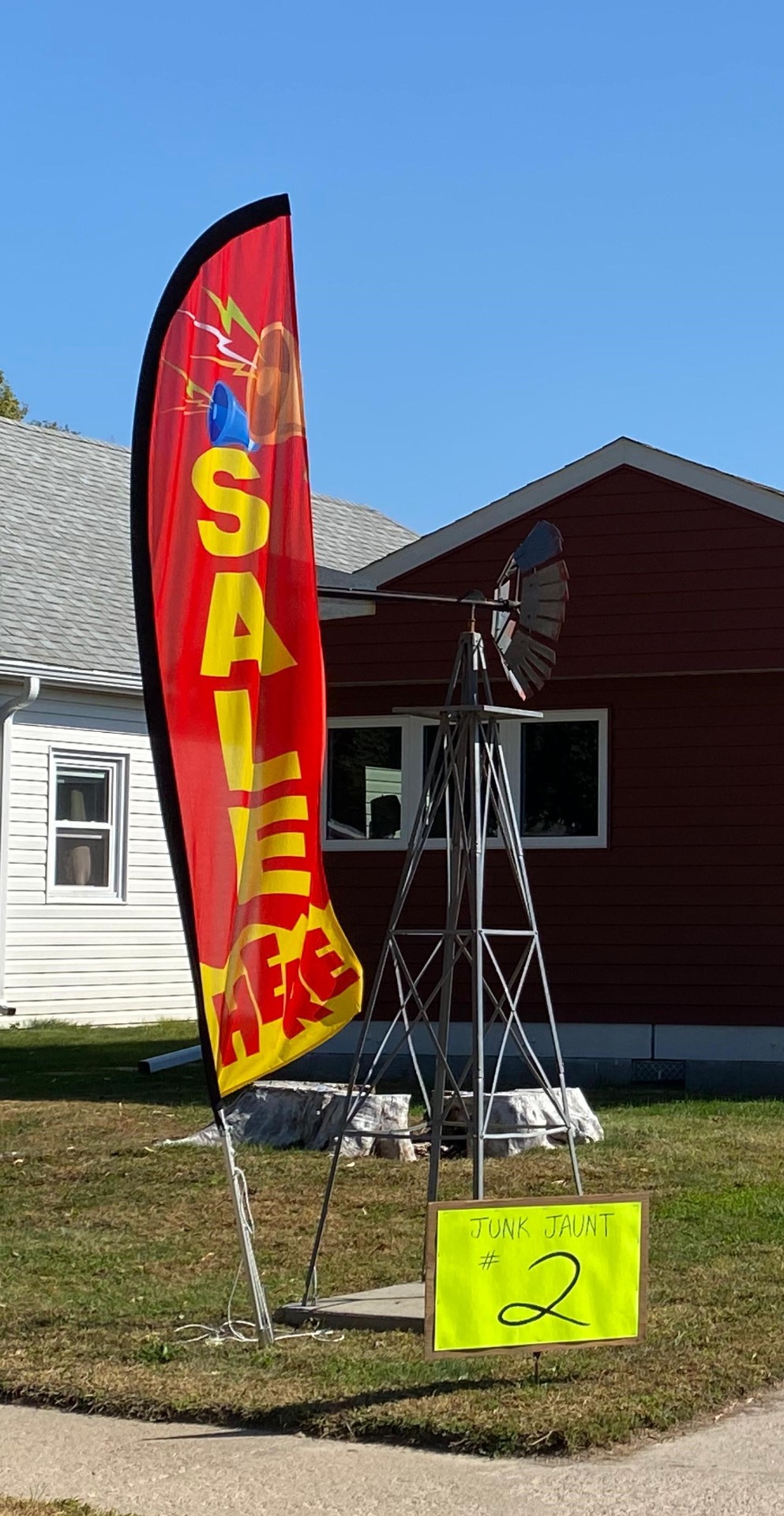
JUNK JUANT - 2025 - Nebraska
For some years already, on the last weekend in September, there is a published "loop route" in central Nebraska of 1) individual "garage sale-type stops" at homes along the route in the country and in towns, 2) at local antique-related businesses, and 3) at "flea market"-type gatherings in rodeo or fair grounds or another large space in a town.
Getting on the road by 7:30 a.m., at 9:00 we got to our first marker of the day, & for the next 11 hours we checked off all the yellow stops along maybe one-fourth of the Junk Jaunt route. It was fabulous to once again be in the country! We drove down roads through thousands of acres of flat fields as far as the eye could see of corn, soybeans, & some other crops. The country life always takes me back to the memories of my first 18 years of life on the farm. So journey along with me & see what home baking-related artifacts were one person's junk (or just no longer used or needed) and became a treasure from this part of the country, the prairie land & the Midwest Grain Belt, for the preservation of our grandmothers' lives.
A
Antlers
Two guys were sitting by these buckets of antlers, & I had never seen so many at one time! Three other family members were nearby, and I jokingly said to all, "Now, how can I justify buying some antlers in relationship to our grandmothers' home baking artifacts?"😂 And then it dawned on me & I said, "I know. In Germany there's a cookie named Springerle (had to explain & a few nodded), & I said that in the old recipes, one of the ingredients was 'hartshorn,' which is ground up antlers!"🙄😀 (I've since found out it's from the male, i.e. stag or hart, red deer species.) Hartshorn is also called "baker's ammonia" & was the rising agent in dough prior to the creation of baking powder in the latter part of the 1800s. In my 1980's Springerle Cookie recipe from Caroline Kallas (dec.) who created and built House-On-The-Hill which sold the carved cookie molds for these cookies, there's 1/2 teaspoon hartshorn to the 6 eggs, 6 c. of powdered sugar, 2# box of cake flour, etc., etc. for one batch, & you need to dissolve the hartshorn in milk for an hour before starting! ($1 a point; $9 -- They guys told me how to measure a "point." If the antler is more than 1" diameter where the point was growing & it's broken off, you pay for a point.)
Learn more here: https://en.wikipedia.org/wiki/Hartshorn
B
Baskets
This is generally known as a strawberry basket because it was the common container in which to sell a quart of strawberries. It doesn't look it, but the left(3) is a pint (half quart). Made of wood veneer (very thin layer); this has a very unusual tin rim. (4 1/2" sq. x 2 1/2"; $1.50)
The right(2) is a 2-quart with the common nailed rim. (6 3/4 x 10" x 4"; $2.10)
Beer Box ~ Bottle & Beer Can Opener (Storz)
Prior to this Junk Jaunt place, I bought a Storz beer (1876-1972) can opener! I remember the company from the years when we first lived in Omaha. What drew my attention & seemed so odd to me was "The Orchid of Beers!" Really? The flavor(??) of a flower, & an orchid at that (!!) for a beer? I don't drink beer, but still . . . ML told me that he got it from a guy who dug it up during some excavation, & it still had the tell-tale signs of proof! (5 1/2" x 8 1/4" x 5"; a gift for this history story) Bottle & Can Opener (4 3/4" x 3/4"; $ .50)


C
Cabbage Slicer (Kraut Hobel) ~ Kraut Stomper (Krautstampfer)
I have so many Kraut Hobels from Germany in the National Bread Museum collection, that I do not need another (I keep saying!). But having to check everything out😉, here this is the first one I've ever seen with information written on it in my half-dozen or so from the U.S. And Joe's sign said to make an offer because he had to clear everything out. So when I asked about the "Kraut Hobel," I knew he'd be curious as to what I was talking about. Seeing I meant the old cabbage slicer, he immediately said, "How's $2?" - - - and I willingly said that I would help him clear stuff out! I had to brush off a layer of dried dirt & wipe it down, & then I saw another amazing thing on the back side . . . the blades are hooked together with a bar you adjust with the wing nut & screw (rusted together today) so that you could adjust the size of the cut of cabbage (also a first)! (9" x 27" x 3 1/2"; box 7 3/4" x 9 1/4" x 3")
The Kraut Stomper is from my 1988-91 Germany years & was at hand to photo with the Cabbage Slicer. (5"rd. x 29")
This site tells a pretty good overall process (whip past the ads): https://practicalselfreliance.com/sauerkraut-crock/
The 2nd photo in this link shows a man using the above Kraut Hobel:
https://deeprootsathome.com/step-by-step-traditional-basic-sauerkraut-in-a-crock/
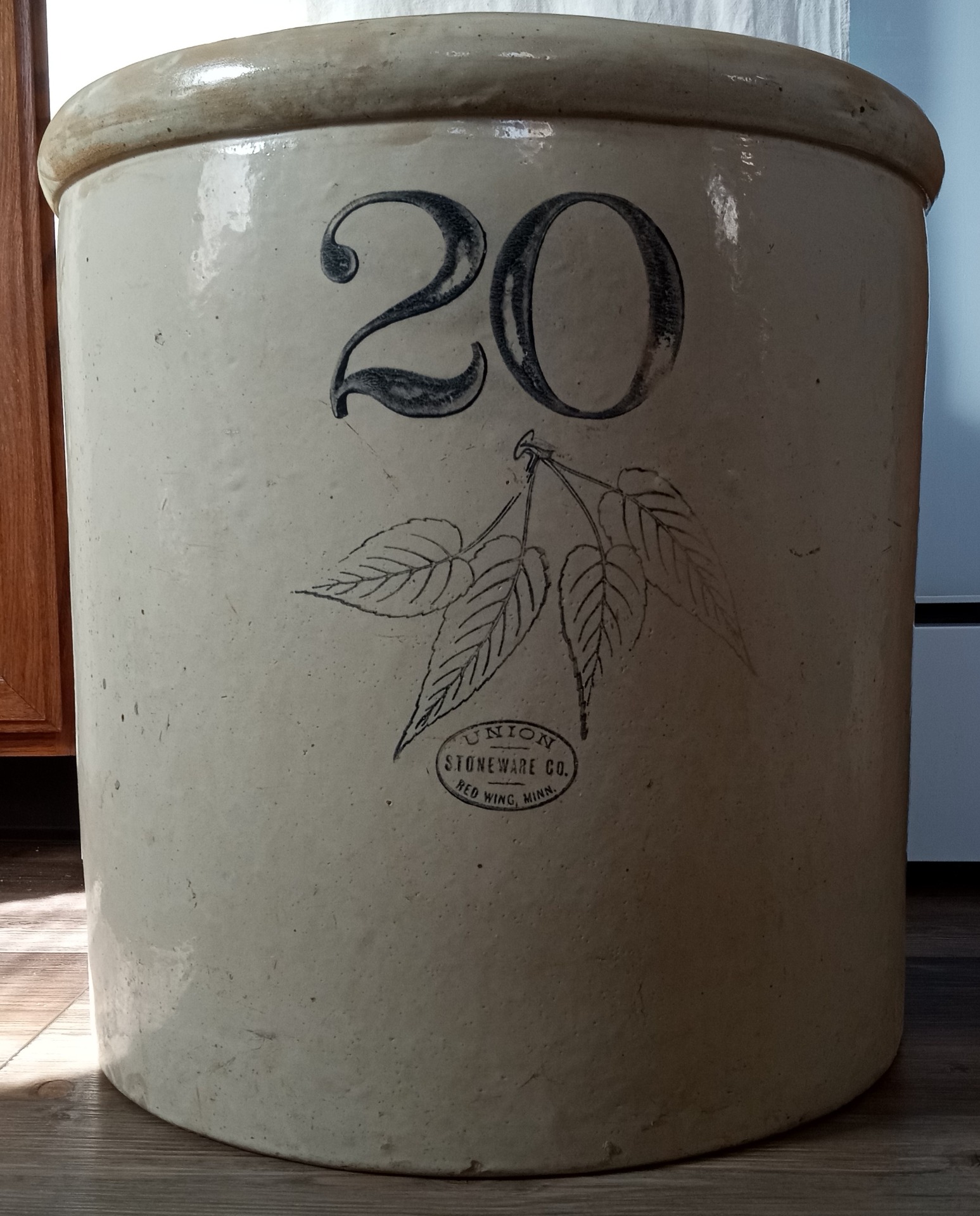
And it just so happened that my traveling partner has been on the lookout for the old crocks - - you put the cabbage in with some salt [spices optional], etc., weight it down with heavy plates or other means, stomp it down however the recipes tell (therefore, the need for a "stomper" like above in the olden days), & through the weeks/months, it will ferment. On the farm, the crocks were kept in the cooler-to-cold temp cellar.
"20" & "4" are the size in gallons. The Red Wing Stoneware Co. had both the Birch Leaf & Red Wing logos. The going price is to pay no more than $10 per gallon if you can find these at that price. These were a bit better than that "good price!"
Cake Molds & Pans
Can Opener
EKCO USA; was a red painted handle with yellow, green, & white rings;
6 7/8" x 1 3/4" x 3/4"; In a $10 bundle of 16.
Canister - Blue Enamelware
In memory of Jana ~ her Graniteware, wood knob & screw handle;
6" rd. x 7 3/4"; $ .50
Canning Jars ~ Covers & related
The first is a white ring with a glass "Atlas EOJ Seal" lid; the 2nd was a new company to me: PRESTO. glass inset in the metal cap/cover. The only cover, but the man even had some PRESTO glass jars for $5 & I now should have gotten one! . . . in hindsight!! ($1.00 for each of the 2 covers.)
The very large-diameter, heavy-wire jar ring & wooden handle - or maybe for a small pail, bucket, jug or other container of some sort?? Handmade/hand wrought; (6 3/8"rd. x 5 3/4" high; in a $10 bundle of 16 items)
Cherry Stoner; Pat. Mar. 3, 1903; No 118 - 2984 (4 other Pat. #s on various parts)
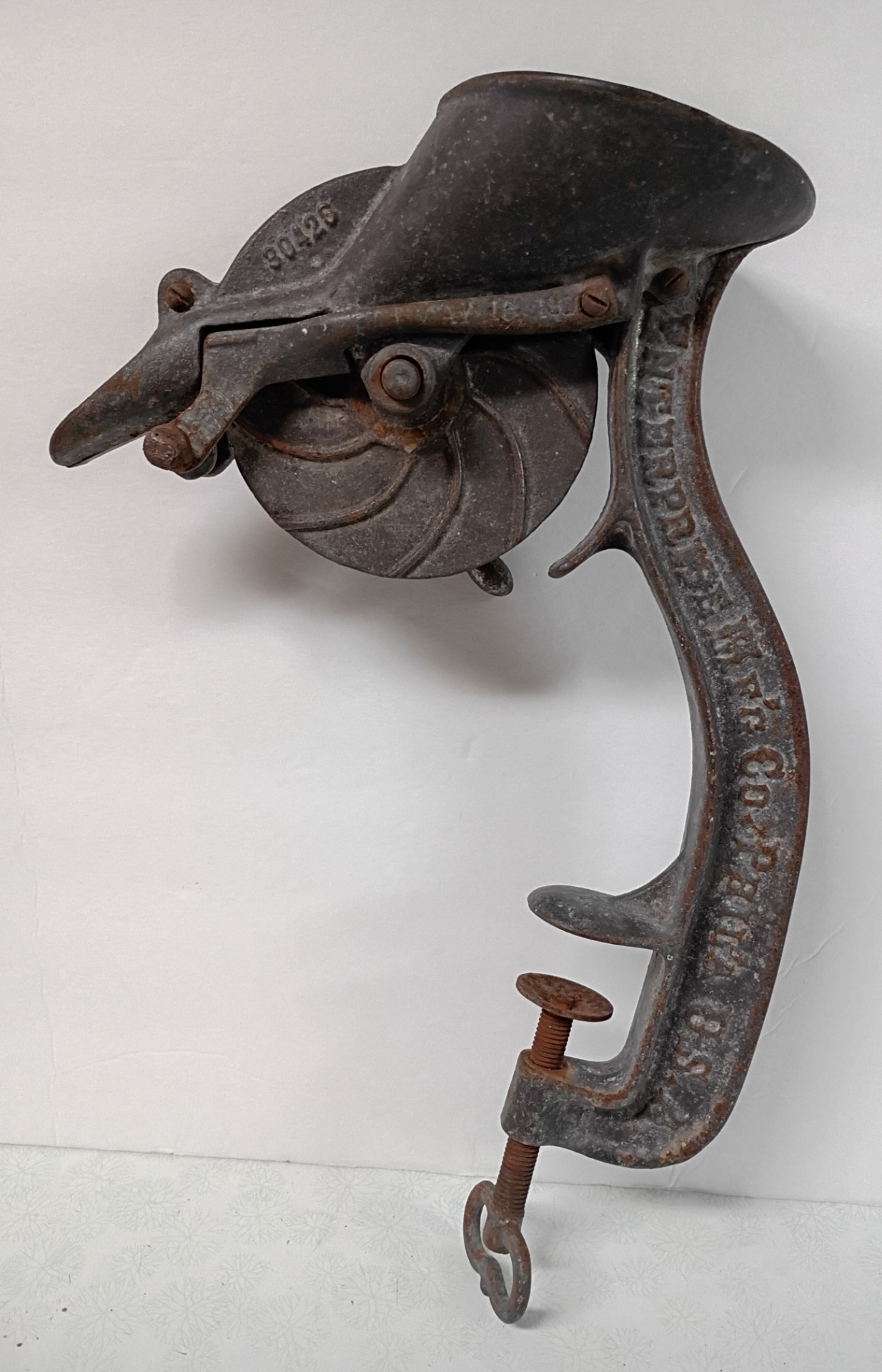
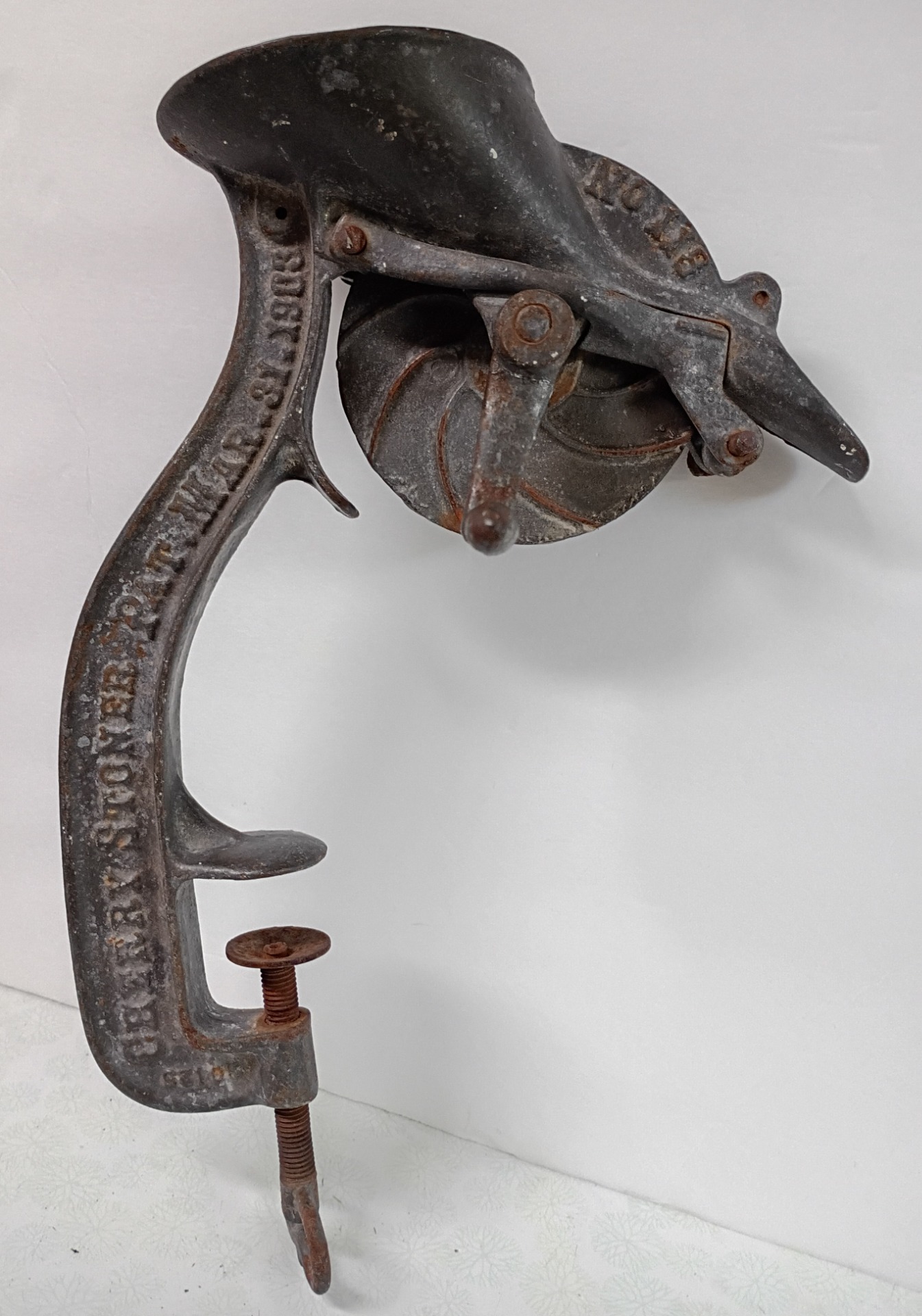
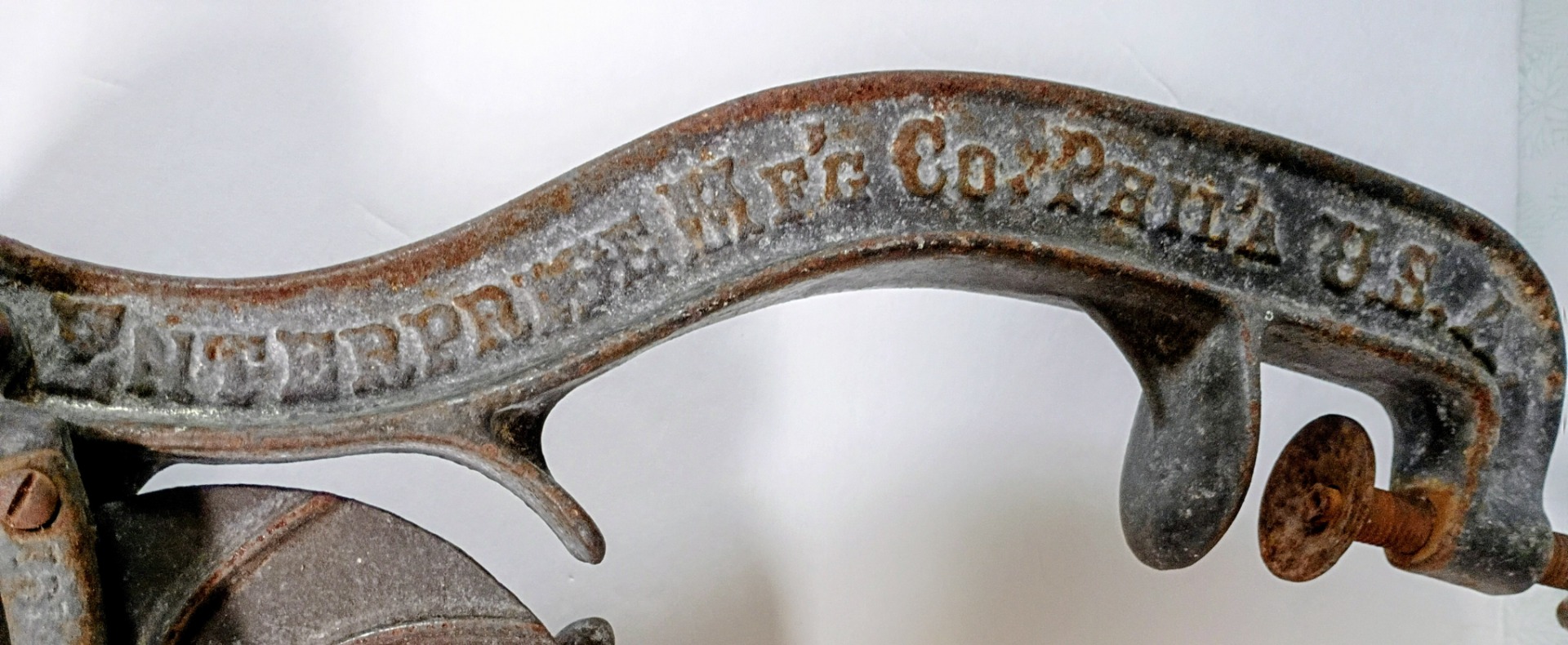
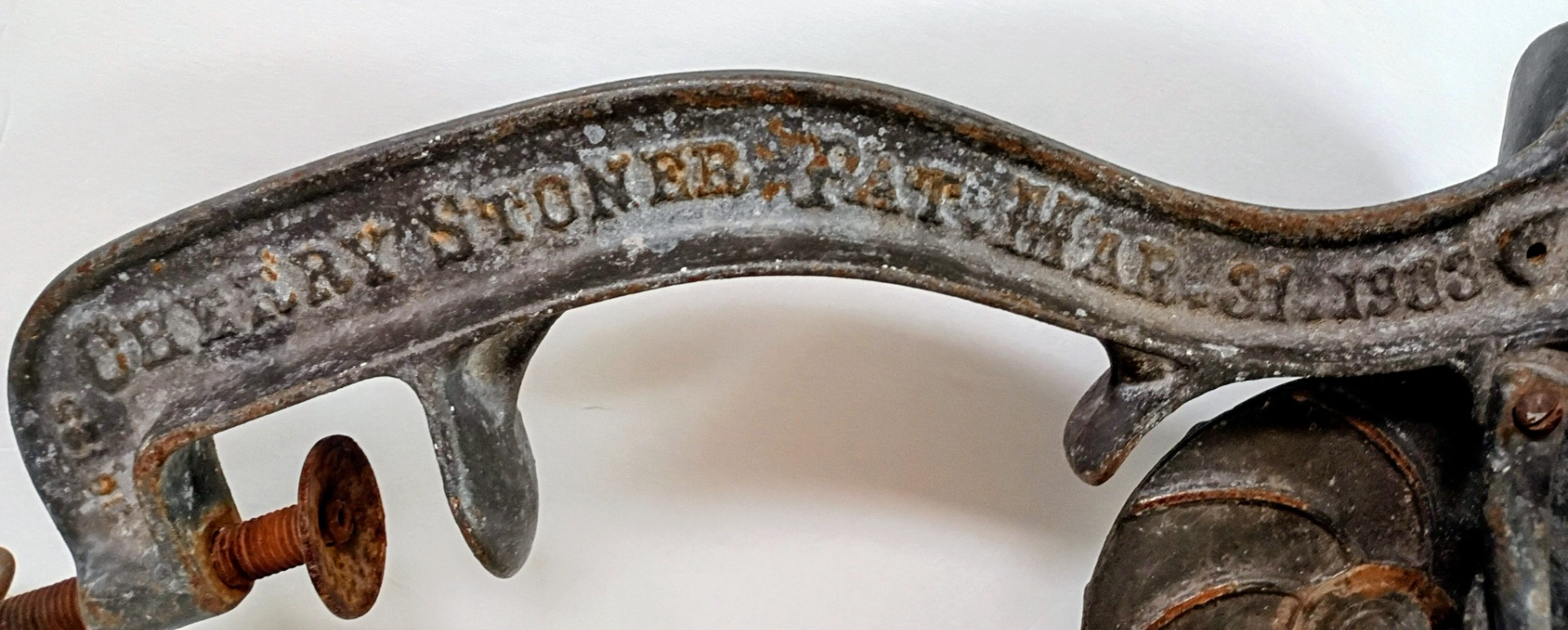
Child's Baking Pans or Baking Tins
Copper Pan, Turkish; Bags of Wine Bottle Corks

Cutter ~ Biscuit or Cookie
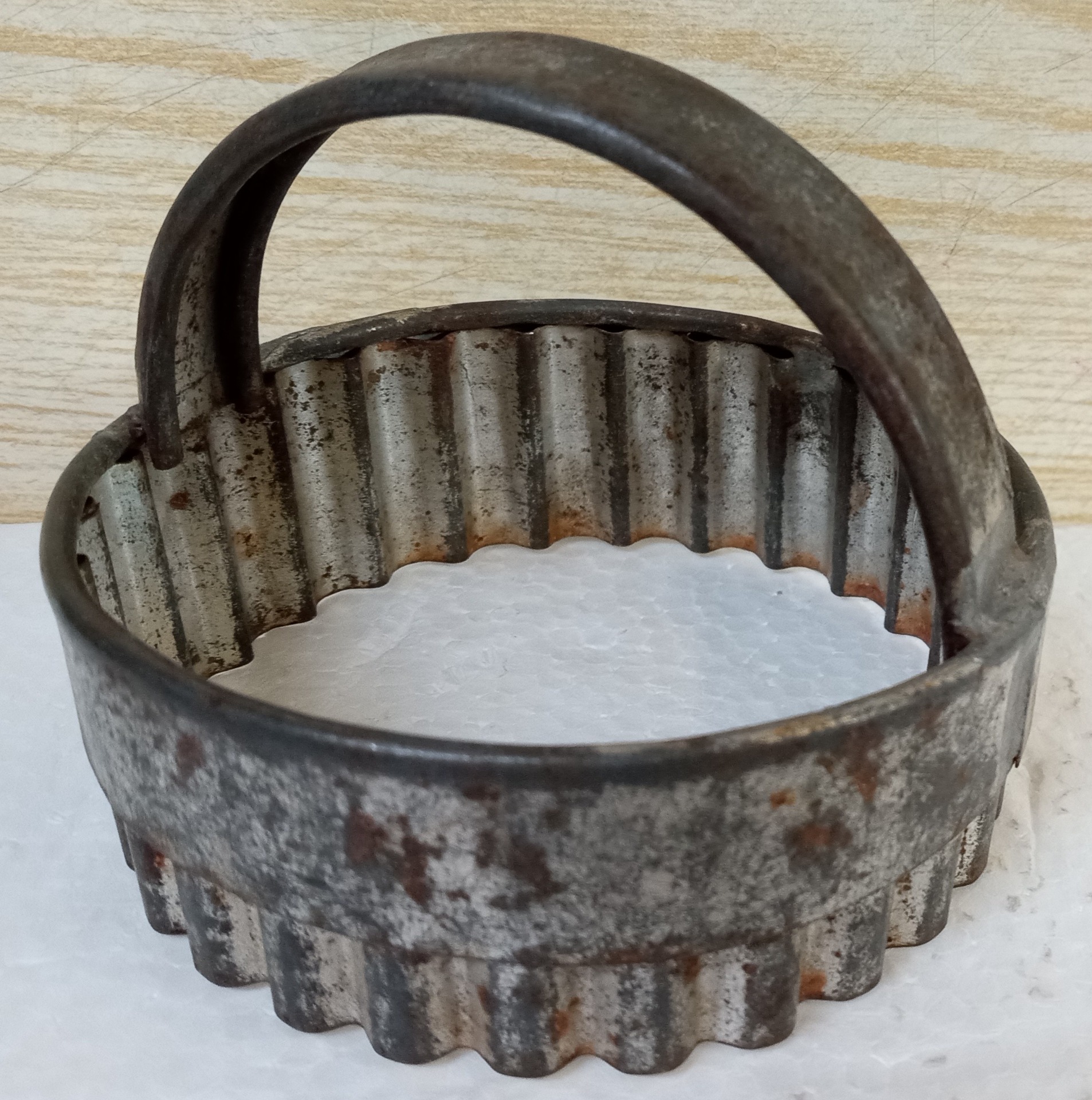
This style is usually categorized as a biscuit cutter with handle. More specifically, scalloped, pierced tin with a heavy duty strap handle. It was already sold in the late 1800s - early 1900s. With no markings, a person needs to judge according to the wear, but many elements can attribute to that, so these kinds of cutters can be newer than older, or vice-versa. I also have them in "set of 3", or more when newer and without handles. When they fit inside each other, it's called "nesting." (3" rd. x 2 1/2" tall w/handle; $ .25)
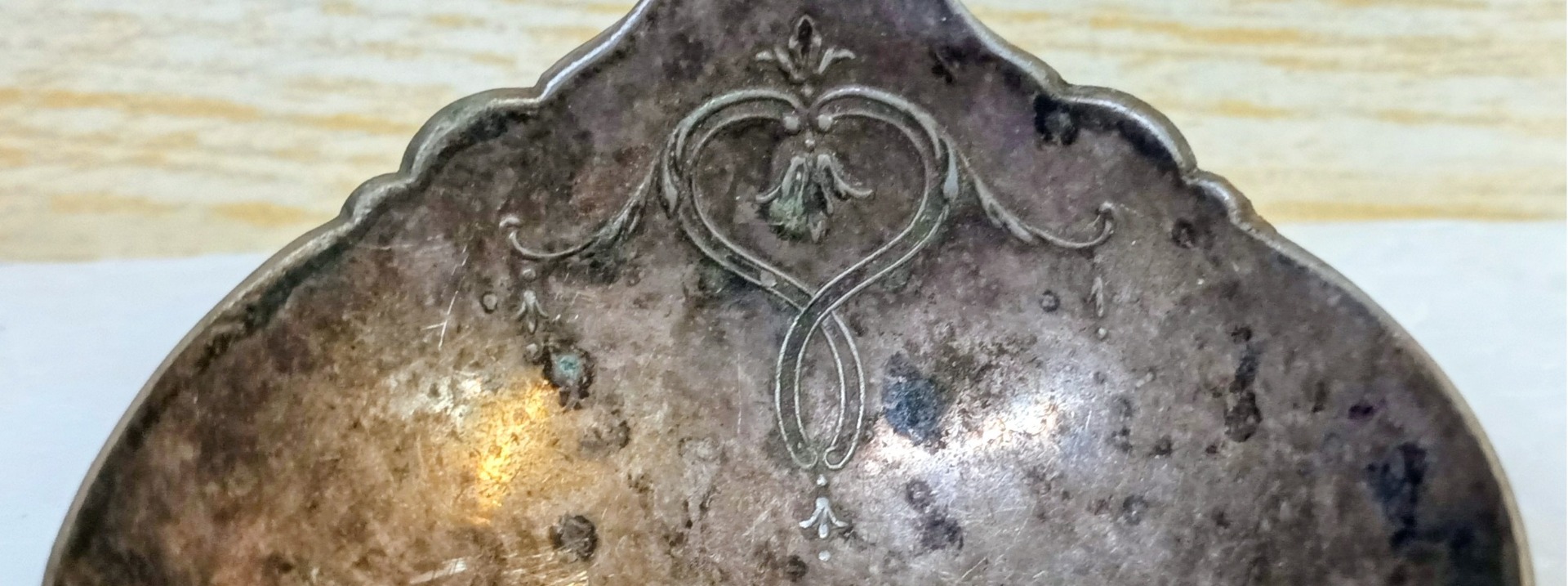
D
Dipper or Ladle - Which is it?


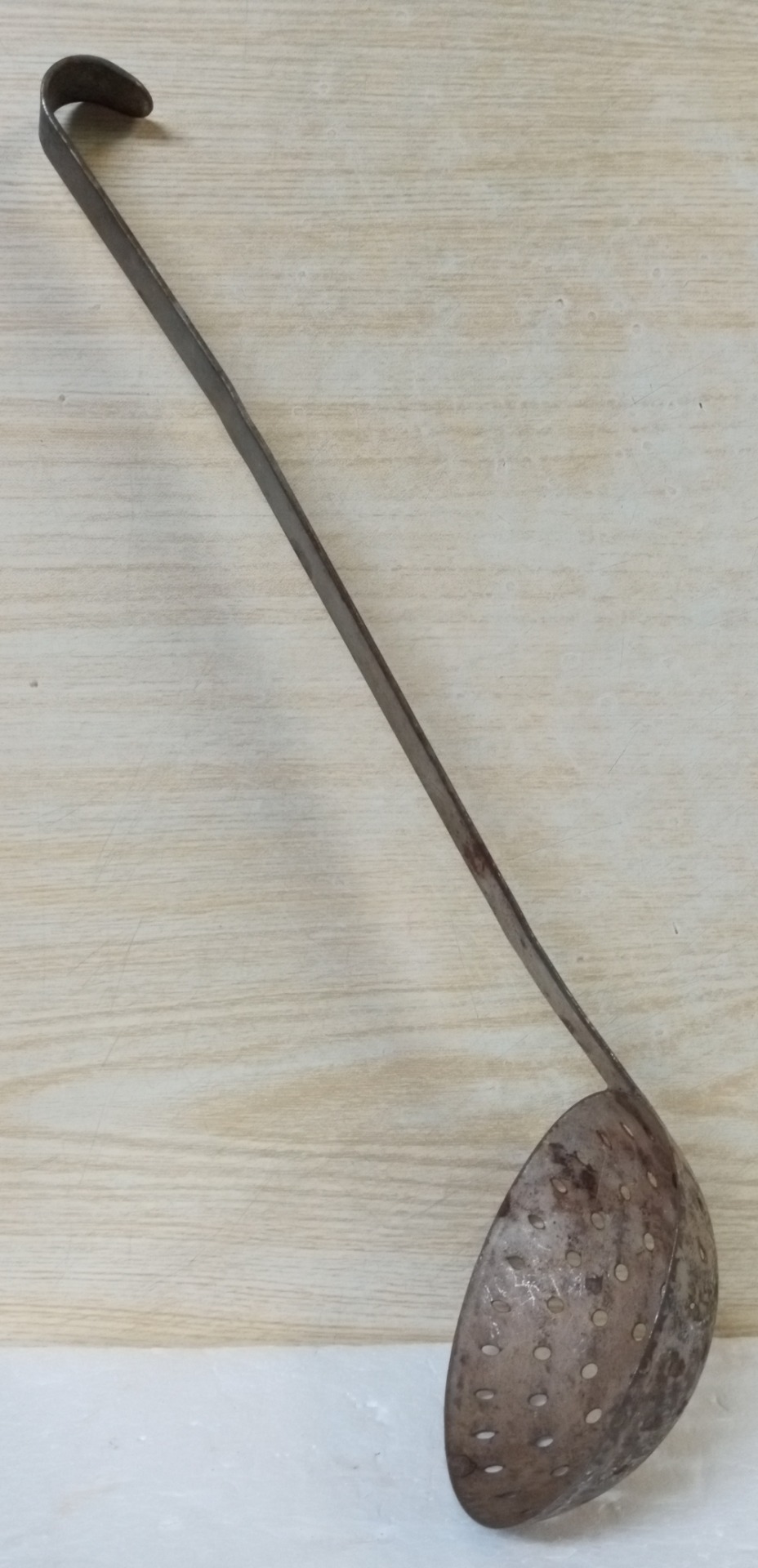
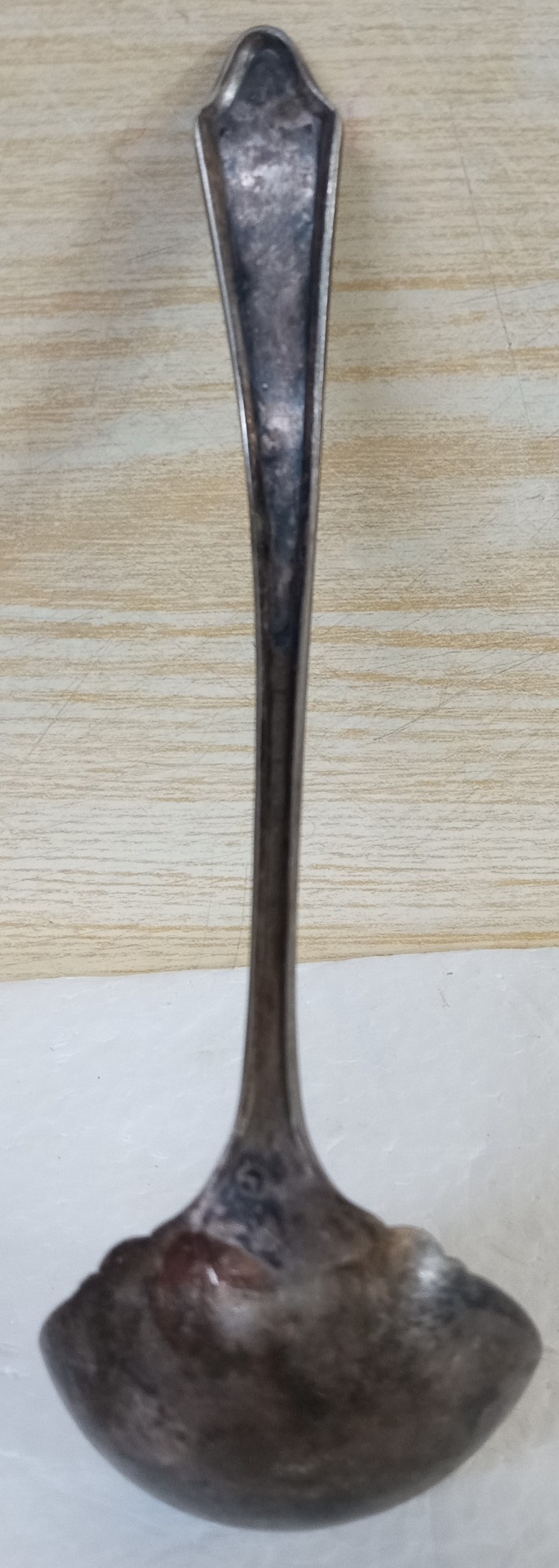

I grew up with people calling the larger "scooping items," with a deeper "bowl," a dipper. The more shallow utensils, like for use in a gravy boat, was called a ladle. After a bit of reading in antique sources, it says it's the opposite! Then again, the angle of the handle to the bowl may determine the difference, OR when it comes down to it . . . the family jargon & the part of the country you live in becomes "the way!" In one of my great sources it says generally ladles are larger than dippers. Really? I always thought the opposite!
Donut Maker (advertised as automatic vs. hand-cutting rolled-out dough)
E
Egg Whip


There can be loads of whips, whisks, beaters, stirrers, spoons, lifters, flippers, & what-have-you in our kitchen drawers or containers on the counter. And each one has specific descriptions according to the manufacturers' names, & the "Kitchen Collectibles" manuals we have as resources today.
Also, each one can command a "pretty penny" (the former lingo in the days-gone-by when the penny meant something), within the so-called "antique" market today. (You do know that an item needs to be 100 years old in order to claim the title of "antique?" -- Right?? So today people have come up with the words of "vintage, collectible, rare, unique, yesteryear, days-gone-by, etc." to claim some sense of a period of age & past time.) Patents for this were the late 1800s - early 1900s. A similar new whip was 5¢ in the 1895 Montgomery Ward catalog.
One of my best sources of learning the details of each of these home-baking artifacts is Linda Campbell Franklin's editions of 300 Year of Kitchen Collectibles. For instance, the "coiled wire 'cross cut' pattern, with (used to be) painted red wood handle" egg whip/whisk pictured here is within the family of "chicken wire, diamond, closer-woven wire called checker, coiled spring, wire-lacing holding springs, & criss-cross springs for the cross-cut pattern," . . . all forms to describe the "wire weaving" of just this one type of kitchen tool to whip an egg or the egg white! And then the outer rim can determine shapes of "flat, spoon, or pear-shaped," besides the wood or wire handles which also have various descriptive names! So with all that history in our grandmothers' lives, each one becomes a treasured keepsake of gratitude to someone's life❣ (3" x 5" oval of the 11 1/4" length; $ .65)
F
Fruit Juicer
Aluminum, "Fits over a cup, strains as it juices" is on the card with the FOLEY Company version in the 1950s. The company was in MPLS, MINN. (Minneapolis, Minnesota), so I'd say it's a Foley even without the name on the juicer. The traditional name for a fruit juicer is "a reamer." (Foley 1950s; 4" round x 8 1/4" x 2 1/2" high; $ .25)
H
Hot Plate from one of the burners of an old wood-burning stove
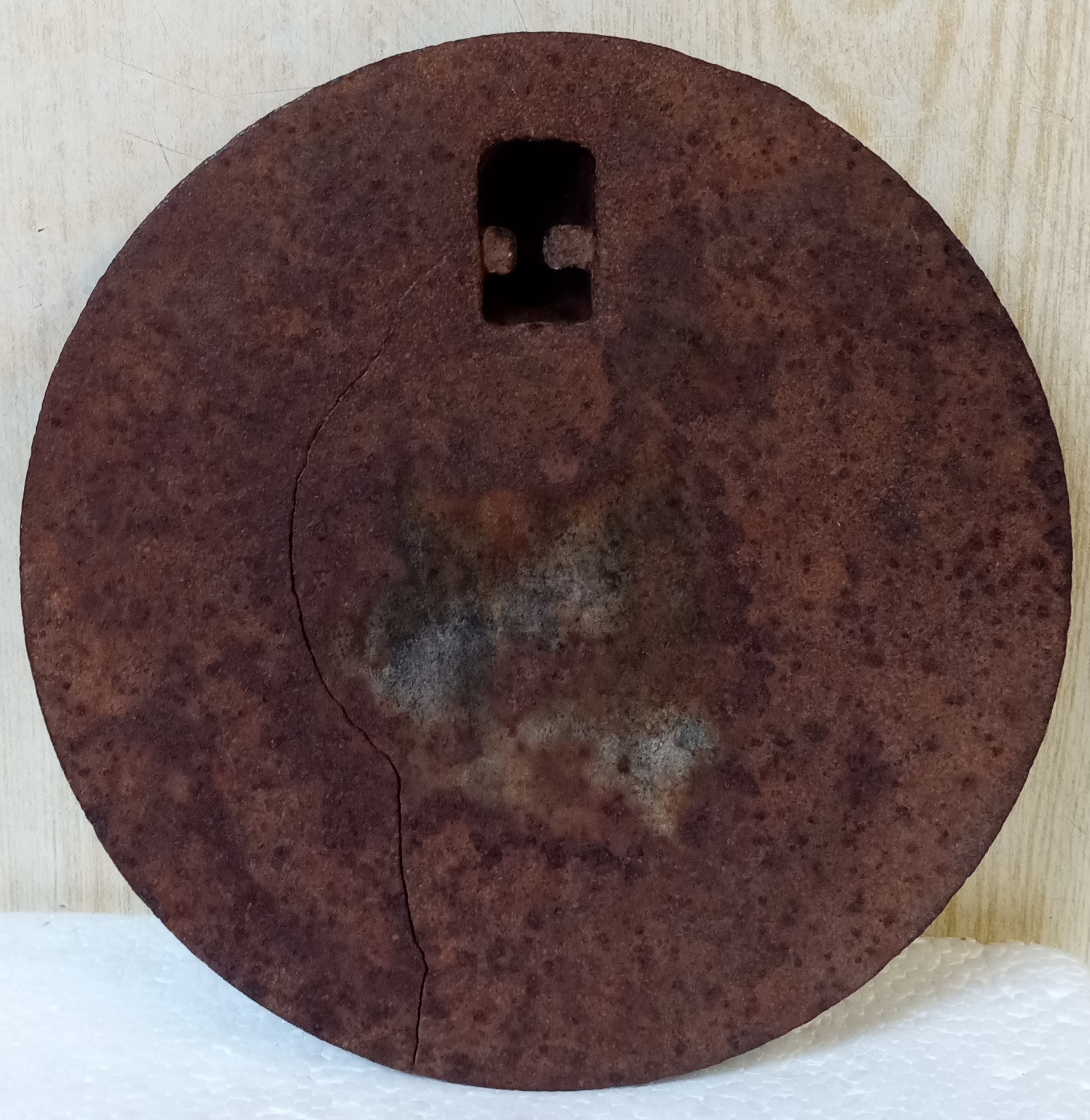
A round piece of heavy iron . . . I wonder what happened to my one grandmother's wood-burning stove, used up into the 1970s? I remember Grandpa opening up the drop-down or a swing-door on one end to insert the pieces of wood he took from the "wood bin" behind the kitchen door, in order to keep the fire going -- the only means of heat in the house. The bin was built in the wall between the enclosed, non-heated back porch & the kitchen-dining room.
So early on in the Junk Jaunt trail, a man had this burner plate for $1.00. Memories of one of the grandparents. There'd be a "handle lifter" to fit in the hole to lift the "hot plate" & stir the fire below. (8" round; $1.00)
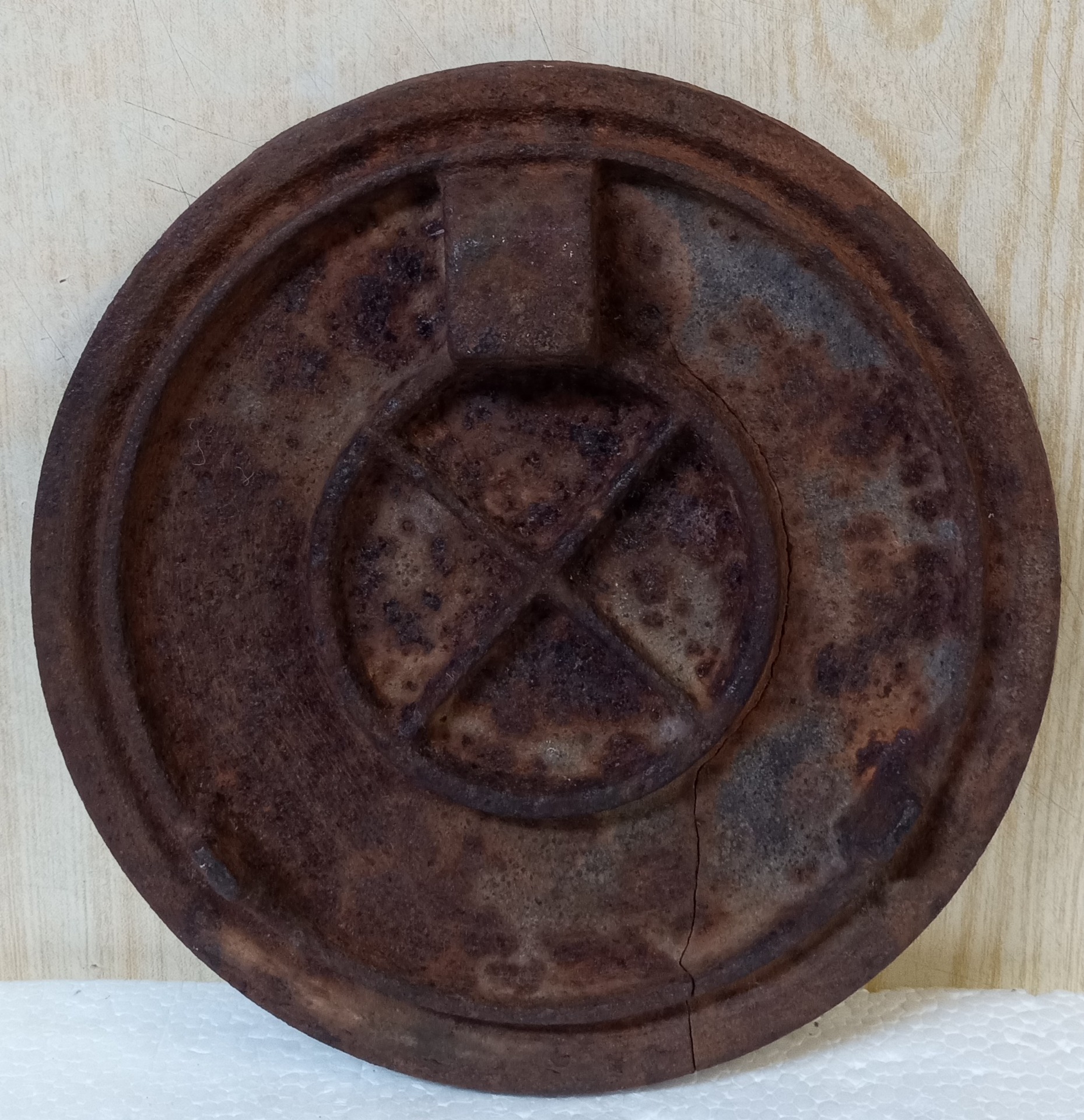
K
Knife / Knives



Knife, double-sided, ripple~scalloped blade (not sharp), possibly for fish scaling?; "stainless Germany"; wooden handle originally painted green; (7 3/4" x 1/2"; in a $10 bundle of 16 items)
M
Maple Syrup Jar
Growing up in Wisconsin, one of the two main maple syrup-producing states, on weekends breakfasts were often pancakes, and especially potato pancakes which a nearby church even used as a festival event each spring with the maple syrup season. We were never short of a-gallon-at-a-time of "the real stuff☺❣" So when I saw this jar, "Oh, what memories!" It was the container in every restaurant (& maybe some homes?) & only for maple syrup. (glass; 3 1/2" rd., 5" w/handle, 5 1/2" tall; $1.00)
P. S. Some of those 2 1/2" fried pork sausage links, a chunk of cheddar cheese, a dollop of butter melting on the top, center of the stack of 2-3 pancakes, & maple syrup running over them onto the plate, is a pancake breakfast👍😋!!!
Masher ~ Melon Baller (utensils
A masher-lifter of some sort; faded green wood handle; (2 3/4"w x 9 1/2", 1/2" x 2" flip; in a $10 bundle of 16 items)
A single scoop melon baller; faded white paint on wooden handle; 5"; $ .50)
Milk Bottles & Caps
On the farm, we drank the "whole milk" from the cows (refrigerated in glass milk bottles). Cream would rise to the top . . . maybe 1-2" in the bottles with the narrow necks. When you wanted to have cream for coffee or tea, or hot oatmeal, whipping, recipes, etc., you'd carefully pour it off or scoop it out. Otherwise, you just shook the bottle of milk to mix it, & we drank it. Also, it's why so many old recipes call for cream. The "up to 75%," heavy, "country-folk population" in this country, 75-150+ years ago always had it available, even if it was store bought (very affordable). Today, after decades of first 2% (when the kids were growing up), then 1%, & now skim milk for many years, a swallow of "2% or whole milk" tastes like cream to me . . . it's so thick!
Regarding the bottle caps, I have no idea where Mom got new ones when needed as we never bought milk. When I went to school & had a container of "pasteurized" white milk (mid-morning break, a half-pint carton, 5¢), I gagged with the horrible taste, so I only drank the chocolate milk as it covered up the pasteurized taste!
N
Newspaper - December 5, 1959
Got to talking with Kevin, wondering what he was looking for when going through a stack of these newspapers. I told him that we got the Wisconsin Agriculturist all of our farm years. That paper had its beginnings in 1877, and is still being published today by Farm Progress. Amazing! After I told Kevin about the historical preservation of this museum project, he showed me that the Nebraska Farmer had a recipe section, so I figured a copy would be a good addition to the archives👍. Click on the photos for a closer look: Robin Hood Flour, Mother's Best Flour, Fleishmann's Yeast, and Festive Yuletide Foods. I wonder how many other states had a "newspaper honoring farmers for their hard work, dedication, farming success, and exemplary leadership?" (10 1/2" x 14 1/2"; $5)
Nut Grinder - Glass Jar
I had the hardest time figuring this out . . . how to chop the nuts into the jar? There is no "cup holder" above the chopping blades, & no way to attach one (if it was a missing piece). Along comes a young guy, looks at it, says you put the nuts INTO the jar, turn the jar upside down, & chop them into a bowl or over your food!!! I couldn't believe it! Who in the world came up with this "reverse method" of all other nut grinders? And WHY? (Doing a search online, I see that originally there was a domed cap or cover that is missing.) "Fed Housewares - Chic IL 5 - Nibot Corp. (3 1/4" rd. x 5"; cover w/handle 3"; $4)
Nut Grinder - Metal, Clamp on something
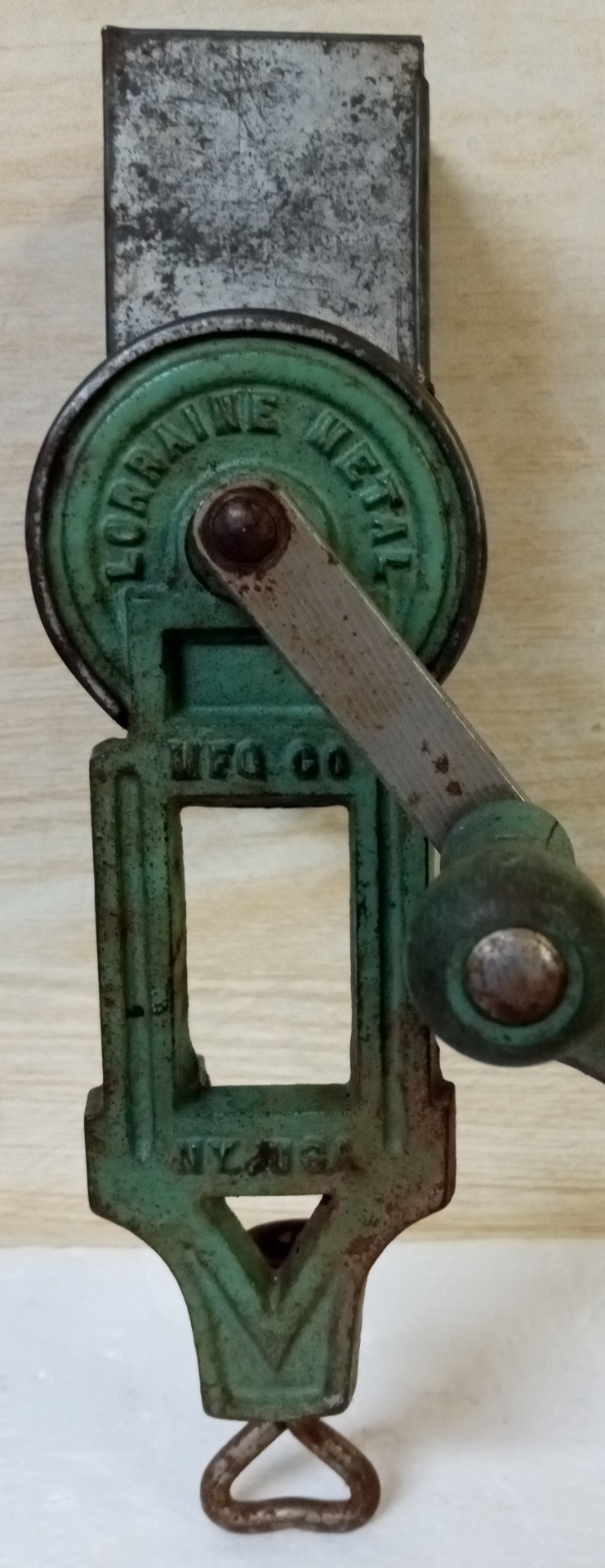
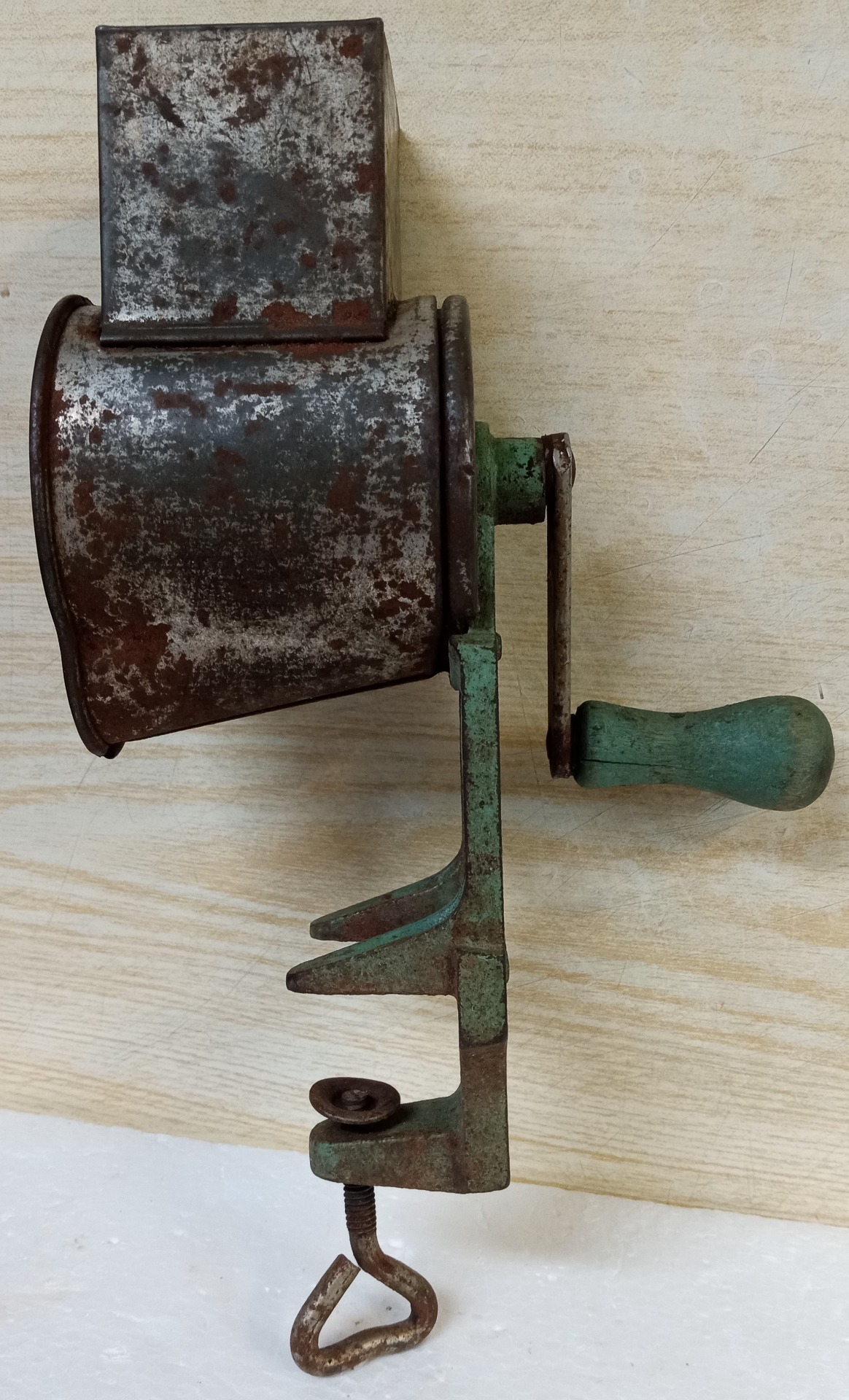
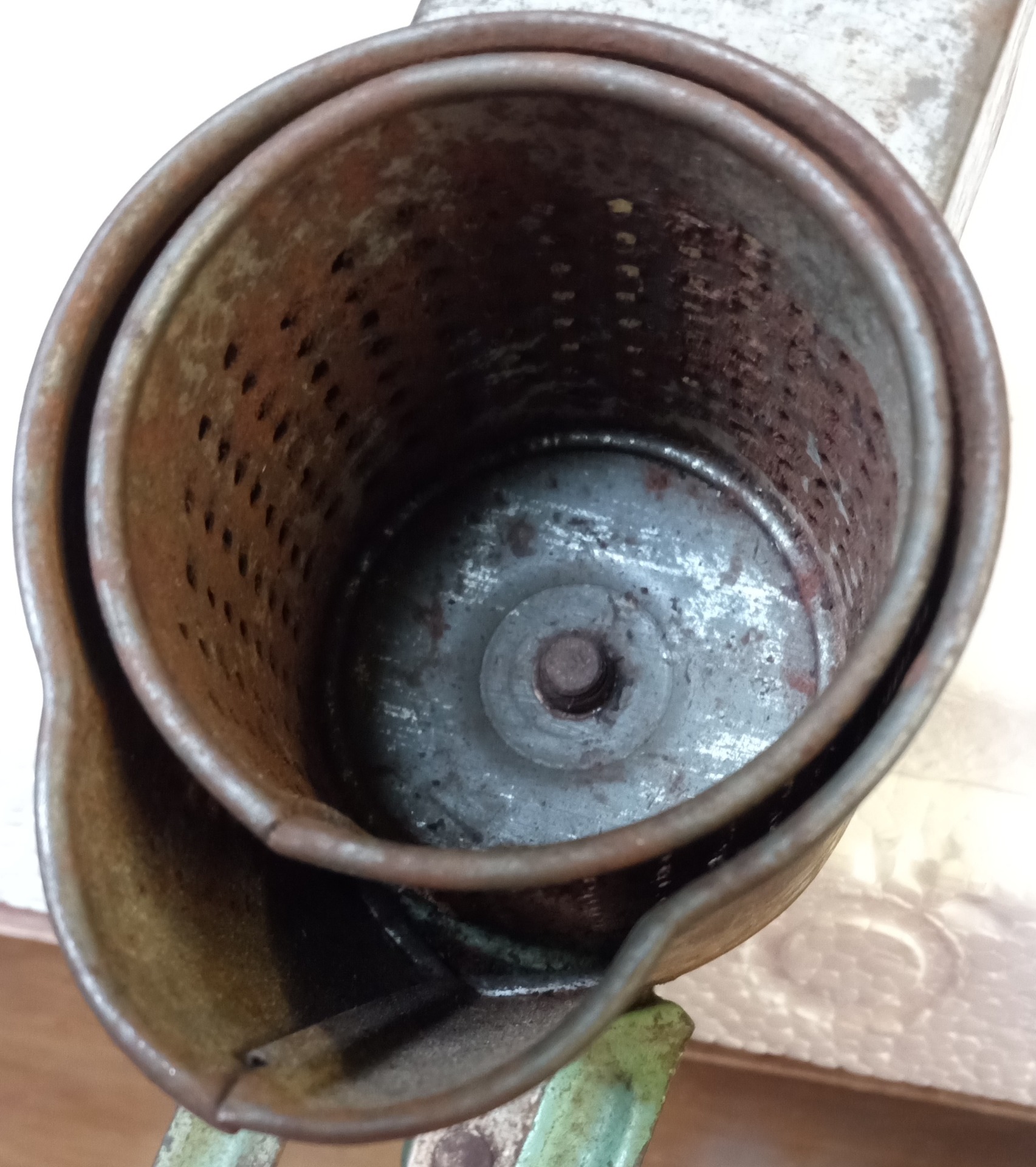
When buying in the German flohmarkts almost each week for 3 years (1988-'91), my face became familiar to a lot of the regular vendors. How I wished I could have spoken more German, but there weren't any of the opportunities to learn as there are today! I was one of the very few Americans who "got out into the everyday German life," as you could live within an "American military community" your entire time if so desired! (What a loss!!)
About 2+ years into my time, a vendor who spoke English invited me to his family home & showed me a very large Dutch antique-collections book. The 2-page centerfold was 2 long shelves filled with these nut grinders, and each had a different name - mostly women! It was astounding. I had no idea. Not having bought a one until that time, I was then on the hunt & within the rest of my time there, & within my bargaining budget, I got enough to fill up the 3 shelves of an old wooden wash stand cabinet I also found ($20), specifically to display these "clamp on" artifacts. And I figured that when the shelves were full, I'd be done buying them! Also, I never bought one without the wooden "pusher" in the feed tube. Then seeing a new style one day with a round, shallow, cup-like feed tube, I asked the vendor what it was for, & when he said, "Mohn," I understood - - a poppy seed grinder! Who knew?!?
I just remember the most expensive one was DM25 -- it was small & had the word "BABY" on it -- very different ($16.50). All these years back here in the U.S. I've seen a few of these in Antique Malls (without pushers & quite $$$), & usually they're called "vegetable choppers" (in this nut grinder style, not like our common meat grinder). But here was one on the Junk Jaunt - by the Lorraine Novelty Mfg. Co., New York, NY., 1950s or earlier. (green; 8 3/4" x 2 3/8" on cup end x 5 1/4" wide; no pusher, but only $2)
LORRAINE, green; 'Metal Mfg. Co., NY USA; 8.75x2.38x5.25 deep; $2
Your Title
This is where your text starts. You can click here to start typing. Sed ut perspiciatis unde omnis iste natus error sit voluptatem accusantium doloremque laudantium totam rem aperiam eaque ipsa quae ab illo inventore veritatis et quasi architecto beatae vitae dicta sunt explicabo nemo enim ipsam voluptatem.

Your Title
This is where your text starts. You can click here to start typing. Dicta sunt explicabo nemo enim ipsam voluptatem quia voluptas sit aspernatur aut odit aut fugit sed quia consequuntur magni dolores eos qui ratione voluptatem sequi nesciunt neque porro quisquam est.
Eos qui ratione voluptatem sequi nesciunt neque porro quisquam est qui dolorem ipsum quia dolor sit amet consectetur adipisci velit sed quia non numquam eius modi tempora incidunt ut labore et dolore magnam aliquam quaerat voluptatem ut enim ad minima veniam.
First heading
This is where your text starts. You can click here to start typing. Sed ut perspiciatis unde omnis iste natus error sit voluptatem accusantium doloremque laudantium totam rem aperiam.
Second heading
This is where your text starts. You can click here to start typing. Sed ut perspiciatis unde omnis iste natus error sit voluptatem accusantium doloremque laudantium totam rem aperiam.